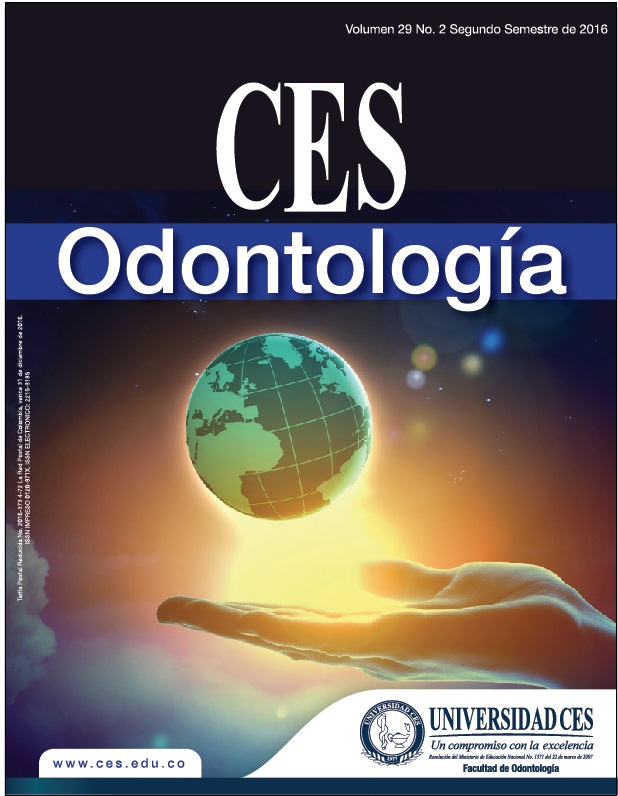Osteonecrosis of the jaws: pathophysiology, diagnosis and treatment
Abstract
The human skeleton is an organized set of bony pieces that make up and provide the structural support of the body. Different functions have been described: dynamic and mechanical support, protection and maintenance of mineral homeostasis. For this, the bone must maintain its active metabolism and be able to adapt its structure to mechanical stimuli repairing the structural damages through the process of remodeling throughout the life. Osteoporosis, Paget’s disease, cancer and bone infections, will alter the physiology of the tissue resulting in the loss of its integrity. Bisphosphonates (BFs) are pharmacological agents designed for the treatment of these diseases, their main mechanism of action is the inhibition of bone osteoclastic resorption. Medication related osteonecrosis of the jaw (ONJ) consists of the progressive destruction of the bone tissue, being one of the adverse effects of this type of treatment. For this reason, the objective of this article was to make a review about the main pharmacological and clinical aspects of ONJs related to bisphosphonates in dentistry. Clinical diagnosis and appropriate treatment are essential to reduce the risk of osteonecrosis in patients undergoing antiresorptive therapy or before starting administration. For this reason, prevention is even more important.Downloads
References
Forrellat M, Fernandez N, Hernandez P. Nuevos conocimientos sobre el metabolismo del hierro. Rev Cubana Hematol Inmunol Hemoter 2005; 21(3):0-0. http://scielo.sld.cu/scielo.php?script=sci_abstract&pid=S0864-02892005000300003
Ganz T. Hepcidin and iron regulation, 10 years later. Blood 2011; 117(17): 4425-4433. https://www.ncbi.nlm.nih.gov/pmc/articles/PMC3099567/
Esquivia MC, Acevedo PA. Hepcidin: Interaction with hemojuvelin and its contribution in the diagnosis of diseases related to iron metabolism. Univ. Méd 2012; 53 (4):382-394. http://bases.bireme.br/cgi-bin/wxislind.exe/iah/online/?IsisScript=iah/iah.xis&src=google&base=LILACS&lang=p&nextAction=lnk&exprSearch=703232&indexSearch=ID
Kemna EHJM, Tjalsma H, Willems NS, Swinkels DW. La hepcidina: desde el descubrimiento hasta el diagnóstico diferencial. Haematologica 2008; 93 (1): 90-97. http://med.javeriana.edu.co/publi/vniversitas/serial/v53n4/Hepcidina.pdf
Batlle AN, Gaisán M, Insunza A. Protocolo diagnóstico de las anemias normocíticas. Medicine 2012; 11(20):1238-1241. http://thirdworld.nl/protocolo-diagnostico-de-las-anemias-normociticas
Agudelo G, Cardona O, Posada M, Montoya M, Ocampo M, Marín C, et al. Prevalencia de anemia ferropénica en escolares y adolescentes, Medellín, Colombia, 1999. Pan Am J Public Health 2003; 13(6):376-386. http://iris.paho.org/xmlui/handle/123456789/8428
Gracia B, de Plata C, Méndez F, Cruz M, Leiva J, Conde L, et al. Evaluación de manifestaciones tempranas de riesgo para enfermedades crónicas no trasmisibles en población escolarizada de Cali-Colombia. Alan 2005; 55 (3): 0-0. http://www.scielo.org.ve/scielo.php?script=sci_arttext&pid=S0004-06222005000300008
Bohórquez M, Bautista A, Valderrama A. Detección de deficiencias subclínicas de hierro a partir del índice receptor soluble de transferrina-ferritina en niños sanos de 1 a 10 años de edad residentes en alturas de 300 y 2600 msnm. Nova 2009; 7(11): 0-0. http://www.scielo.org.co/pdf/rmri/v20n2/v20n2a06.pdf
Mantilla GC, Pérez R, Cardona AJ. Hierro corporal en donantes habituales de un banco de sangre de Medellín-Colombia. Rev Cubana Hematol Inmunol Hemoter 2014; 30(3):233-242 http://scielo.sld.cu/scielo.php?script=sci_abstract&pid=S0864-02892014000300006
Forrellat M, Fernandez N. Hepcidina: nueva molécula, nuevos horizontes. Rev Cubana Hematol Inmunol Hemoter 2004; 20(3): 0-0. http://scielo.sld.cu/scielo.php?pid=S0864-02892004000300003&script=sci_abstract&tlng=en
Villarroel P, Arredondo M, Olivares M. Anemia de las enfermedades crónicas asociada a obesidad: papel de la hepcidina como mediador central. Rev. méd. Chile 2013;141 (7):887-894. http://www.scielo.cl/pdf/rmc/v141n7/art08.pdf
Arosio P. New signaling pathways for hepcidin regulation. Blood 2014; 123(10):1433-1434 http://www.bloodjournal.org/content/123/10/1433?sso-checked=true
Weiss G, Goodnough LT. Anemia of chronic disease. N Engl J Med 2005;352(10):1011-1023 http://www.nejm.org/doi/full/10.1056/NEJMra041809
Theurl I, Aigner E, Theurl M, Nairz M, Seifert M, Schroll A, et al. Regulation of iron homeostasis in anemia of chronic disease and iron deficiency anemia: diagnostic and therapeutic implications. Blood 2009;113(21):5277-5286 https://www.ncbi.nlm.nih.gov/pubmed/19293425
Nicolas G, Chauvet C, Viatte L, Danan JL, Bigard X, Devaux I, et al. The gene encoding the iron regulatory peptide hepcidin is regulated by anemia, hypoxia, and inflammation. J Clin Invest 2002; 110 (7):1037-1044. https://www.ncbi.nlm.nih.gov/pubmed/12370282
Kemna E, Pickkers P, Nemeth E, van der Hoeven H, Swinkels D. Time-course analysis of hepcidin, serum iron, and plasma cytokine levels in humans injected with LPS. Blood 2005;106(5):1864-1866 http://www.bloodjournal.org/content/106/5/1864
Wessling-Resnick M. Iron homeostasis and the inflammatory response. Annu Rev Nutr 2010; 30: 105-122. https://www.ncbi.nlm.nih.gov/pubmed/20420524
Ferrucci L, Semba RD, Guralnik JM, Ershler WB, Bandinelli S, Patel KV, et al. Proinflammatory state, hepcidin, and anemia in older persons. Blood 2010; 115 (18):3810-3816. https://www.ncbi.nlm.nih.gov/pubmed/20081092
Murphy AT, Witcher DR, Luan P, Wroblewski VJ. Quantitation of hepcidin from human and mouse serum using liquid chromatography tandem mass spectrometry. Blood 2007; 110: 1048-1054. www.ncbi.nlm.nih.gov/pubmed/17435114
Coyne DW. Hepcidin: clinical utility as a diagnostic tool and therapeutic target. Kidney Int. 2011; 80(3):240-244. https://www.ncbi.nlm.nih.gov/pubmed/21677632
Piperno A, Mariani R, Trombini P, Girelli D. Hepcidin modulation in human diseases: from research to clinic. World J Gastroenterol 2009;15(5):538-551 https://www.ncbi.nlm.nih.gov/pmc/articles/PMC2653344/
Pigeon C, Ilyin G, Courselaud B, Leroyer P, Turlin B, Brissot P, et al. A new mouse liver-specific gene, encoding a protein homologous to human antimicrobial peptide hepcidin, is overexpressed during iron overload. J Biol Chem 2001; 276 (11):7811-7819. https://www.ncbi.nlm.nih.gov/pubmed/11113132
Ganz T, Nemeth E. Hepcidin and iron homeostasis. Biochimica et Biophysica Acta 2012; 1823(9):1434-1443. https://www.ncbi.nlm.nih.gov/pubmed/22306005
Peters HPE, Laarakkers CMM, Swinkels DW, Wetzels JFM. Serum hepcidin-25 levels in patients with chronic kidney disease are independent of glomerular filtration rate. Nephrol Dial Transplant 2010; 25 (3):848-853. https://www.ncbi.nlm.nih.gov/pubmed/19854845
Kroot JJ, Tjalsma H, Fleming RE, Swinkels DW. Hepcidin in human iron disorders: diagnostic implications. Clin. Chem 2011; 57(12): 1650–1669. https://www.ncbi.nlm.nih.gov/pubmed/21989113
Bekri S, Gual P, Anty R, Luciani N, Dahman M, Ramesh B, et al. Increased adipose tissue expression of hepcidin in severe obesity is independent from diabetes and NASH. Gastroenterology 2006; 131 (3):788-796. https://www.ncbi.nlm.nih.gov/pubmed/16952548
Kroot JJ, Hendriks JC, Laarakkers CM, Klaver SM, Kemna EH, Tjalsma H, et al. (Pre) analytical imprecision, between-subject variability, and daily variations in serum and urine hepcidin: implications for clinical studies. Anal. Biochem. 2009; 389(2): 124–129. https://www.ncbi.nlm.nih.gov/pubmed/19341701
Galesloot TE, Vermeulen SH, Geurts-Moespot AJ, Klaver SM, Kroot JJ, van Tienoven D, et al. Serum hepcidin: reference ranges and biochemical correlates in the general population. Blood 2011; 117(25): 218-225. https://www.ncbi.nlm.nih.gov/pubmed/21527524
Bartnikas TB, Andrews NC, Fleming MD. Transferrin is a major determinant of hepcidin expression in hypotransferrinemic mice. Blood 2010; 117(2):630-637. https://www.ncbi.nlm.nih.gov/pubmed/20956801
Ganz T, Olbina G, Girelli D, Nemeth E, Westerman M. Immunoassay for human serum hepcidin. Blood 2008;112(10):4292-497 https://www.ncbi.nlm.nih.gov/pubmed/18689548
DRG DIAGNOSTICS. Hepcidin 25 bioactive elisa (EIA-5258): Instructions for Use [sitio en internet]. Hallado en URL: <http://www.drg-diagnostics.de/118-1-drg+hepcidin+elisa.html> Acceso en octubre 2 de 2015
Wolff F, Deleers M, Melot C, Gulbis B, Cotton F. Hepcidin-25: Measurement by LC-MS/MS in serum and urine, reference ranges and urinary fractional excretion. Elsevier Inc 2013; 413: 99-104. http://www.archivosdemedicina.com/medicina-de-familia/hepcidina-serica-en-donantes-de-sangre-y-pacientes-con-alteraciones-en-el-metabolismo-del-hierro.php?aid=8862
Itkonen O, Parkkinen J, Stenman U, Hämäläinen E. Preanalytical factors and reference intervals for serum hepcidin LC-MS/MS method. Elsevier Inc 2012; 423: 696-701.
Murphy A, Witcher D, Luan P, Wroblewski V. Quantitation of hepcidin from human and mouse serum using liquid chromatography tandem mass spectrometry. Blood 2007; 110: 1048-1054. https://www.ncbi.nlm.nih.gov/pubmed/17435114
Mecklenburg I, Reznik D, Fasler-Kan E, Drewe J, Beglinger C, Hruz P, et al. Serum hepcidin concentrations correlate with ferritin in patients with inflammatory bowel disease. J Crohns Colitis 2014; 8(11): 1392–1397 https://www.ncbi.nlm.nih.gov/pubmed/24825446
Pasricha SR, McQuilten Z, Westerman M, Keller A, Nemeth E, Ganz T, et al. Serum hepcidin as a diagnostic test of iron deficiency in premenopausal female blood donors. Haematologica. 2011; 96(8):1099-1105. http://www.haematologica.org/content/96/8/1099
Mast AE, Schlumpf KS, Wright DJ, Johnson B, Glynn SA, Busch MP, et al. Hepcidin level predicts hemoglobin concentration in individuals undergoing repeated phlebotomy. Haematologica 2013; 98 (8):1324–1330. https://www.ncbi.nlm.nih.gov/pubmed/23445875
Downloads
Published
How to Cite
Issue
Section
| Article metrics | |
|---|---|
| Abstract views | |
| Galley vies | |
| PDF Views | |
| HTML views | |
| Other views | |



